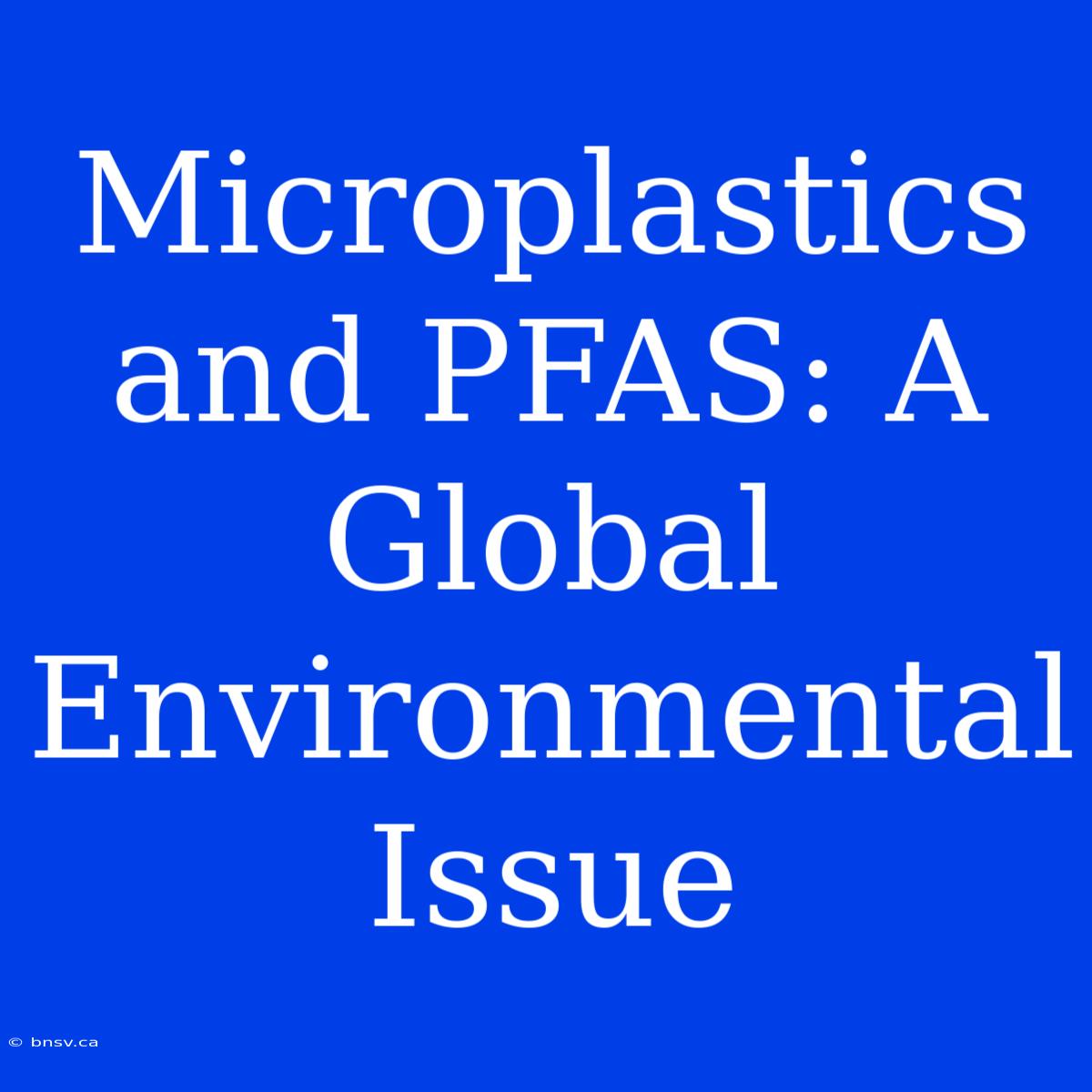Microplastics and PFAS: A Global Environmental Issue
Microplastics and PFAS: A Toxic Duo Threatening Our Planet
Editor's Note: This article explores the escalating concerns surrounding microplastics and PFAS (per- and polyfluoroalkyl substances), two pervasive environmental contaminants that pose significant risks to human and ecosystem health. Today, we delve into the nature of these pollutants, their sources, and the potential consequences of their widespread presence.
Analysis: Microplastics and PFAS are increasingly recognized as global environmental threats due to their persistence, widespread distribution, and potential toxicity. This article provides a comprehensive overview of these contaminants, drawing on the latest scientific research and data, and offers insights into their impact on the environment and human health.
The Dual Threat of Microplastics and PFAS
Microplastics are tiny plastic particles less than 5 millimeters in diameter, often invisible to the naked eye. They originate from various sources, including the breakdown of larger plastic items, industrial processes, and synthetic fibers released during washing.
PFAS are a group of synthetic chemicals with unique properties that make them useful in various industries. These "forever chemicals" resist heat, oil, and water, but they also persist in the environment, bioaccumulate in organisms, and pose potential health risks.
Key Aspects
- Sources and Pathways: Microplastics and PFAS enter the environment through various pathways, including wastewater, industrial discharges, agricultural runoff, and atmospheric deposition.
- Environmental Impacts: Both contaminants accumulate in soil, water, and air, posing threats to wildlife, aquatic ecosystems, and human health.
- Health Concerns: Microplastics can cause physical damage to organisms, while PFAS are linked to a range of health issues, including immune suppression, endocrine disruption, and cancer.
- Global Distribution: Microplastics and PFAS are found globally, from remote polar regions to the deepest oceans, highlighting their pervasive nature.
Microplastics: A Tiny Threat with Global Reach
Sources:
- Industrial Processes: Manufacturing, construction, and textiles contribute significantly to microplastic pollution.
- Consumer Products: Single-use plastics, clothing, and packaging are major sources of microplastics.
- Waste Management: Improper waste disposal and plastic degradation lead to the release of microplastics into the environment.
Impacts:
- Aquatic Ecosystems: Microplastics accumulate in the food chain, posing risks to marine life and affecting their survival.
- Human Health: Microplastics can enter the human body through ingestion, inhalation, and skin absorption, potentially causing inflammation and other health problems.
- Environmental Degradation: Microplastics contribute to plastic pollution, affecting soil fertility and water quality.
PFAS: Persistent Chemicals with Long-lasting Consequences
Sources:
- Industrial Applications: PFAS are used in a wide range of products, including non-stick cookware, firefighting foams, and food packaging.
- Wastewater Treatment: PFAS can be released from industrial processes and wastewater treatment plants, contaminating water sources.
- Agricultural Practices: PFAS can be used in agricultural settings to improve water repellency, leading to environmental contamination.
Impacts:
- Water Contamination: PFAS persist in water bodies, posing threats to drinking water supplies and aquatic ecosystems.
- Bioaccumulation: PFAS bioaccumulate in the food chain, potentially causing harm to wildlife and human health.
- Health Risks: Exposure to PFAS is linked to various health issues, including immune deficiency, liver damage, and hormone disruption.
Microplastics and PFAS: A Global Challenge
Mitigation and Solutions:
- Waste Reduction and Recycling: Reducing plastic consumption and promoting recycling can significantly reduce microplastic pollution.
- Sustainable Alternatives: Utilizing biodegradable plastics and exploring alternative chemical compounds can help minimize environmental contamination.
- Regulation and Monitoring: Implementing stricter regulations on PFAS production and use, and monitoring their presence in the environment are crucial.
- Public Awareness: Raising awareness about the risks of microplastics and PFAS and promoting responsible practices are essential.
FAQ
Q: What are the most common types of microplastics? A: Common types include fibers, fragments, films, and beads.
Q: What are the health risks associated with PFAS? A: Potential health risks include immune deficiency, liver damage, hormone disruption, and cancer.
Q: How can I reduce my exposure to microplastics and PFAS? A: You can reduce exposure by choosing reusable products, avoiding single-use plastics, and being mindful of your food choices.
Tips for Reducing Your Impact
- Choose reusable alternatives: Replace single-use plastic bags, bottles, and containers with reusable options.
- Support sustainable brands: Look for brands committed to reducing plastic waste and using eco-friendly materials.
- Properly dispose of plastics: Recycle plastic waste whenever possible and dispose of it responsibly.
- Avoid non-stick cookware and packaging: Opt for cookware and packaging made from sustainable materials.
- Stay informed: Stay informed about the latest research on microplastics and PFAS and make informed choices.
Summary: Microplastics and PFAS are emerging environmental threats with far-reaching consequences. Their persistence, widespread distribution, and potential toxicity necessitate immediate action to mitigate their impact on human health and ecosystems.
Closing Message: The challenge of microplastics and PFAS requires a global response, combining scientific research, regulatory action, and public awareness. By working together, we can protect our planet and ensure a healthy future for generations to come.

